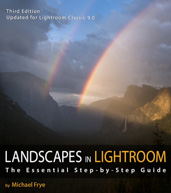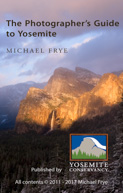In the Moment:
Michael Frye's Landscape Photography Blog
by Michael Frye | Jul 8, 2014 | Light and Weather, Travels and Stories
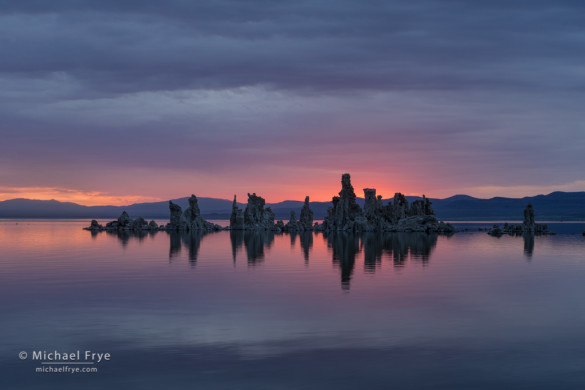
Sunrise at South Tufa, Mono Lake, Monday morning
Claudia and I have been in Lee Vining, on the eastern side of the Sierra, preparing for my Hidden Yosemite workshop. The weather over Mono Lake the last few days has been really interesting and moody, with some light showers, rainbows, and skies full of beautifully-textured clouds. In between scouting and setting up we’ve photographed a couple of sunsets and a sunrise at the lake, and I’ve included some of the images here.
The last photo might be the most unusual rainbow I’ve ever seen. Claudia, my workshop assistant Kirk Keeler, and I were walking out of the Whoa Nellie Deli after dinner last night when we spotted a rainbow. We drove quickly toward the lake, where we found a short, vivid section of the rainbow over a zigzag shoreline. The rainbow was formed by the sun poking through a small hole in the clouds and hitting a rain squall, which made it look like the rainbow was suspended in space and creating a sunbeam.
Forecasts call for similar weather over the next few days, so I’m looking forward to a great week with our group!
— Michael Frye
(more…)
by Michael Frye | Jul 3, 2014 | Critiques
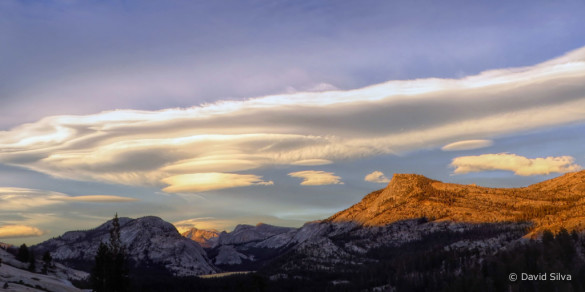
Lenticular Clouds, Tioga Pass, Yosemite, by David Silva
It’s been awhile, but I thought it was time to post another photo critique. This time I’ll look at an image by David Silva from Yosemite’s high country.
Light and Weather
David found some amazing lenticular clouds flowing over Yosemite’s high peaks just before sunset. (Where was I that day?) David told me that he and his wife were driving over Tioga Pass to the eastern Sierra when he noticed some interesting clouds forming. He considered stopping earlier, but decided to push on to Olmsted Point, and was able to make it there in time to catch the light on the clouds and peaks before the sun set.
This was perfect timing. There’s a nice orange glow on the highest peaks, creating a warm-cool color contrast. The last light highlights Mt. Conness in the distance, creating a small-but-important focal point. The clouds fit into the gap between the peaks is perfectly. There’s a beautiful, dramatic, late-day mood to the scene.
(more…)
by Michael Frye | Jun 30, 2014 | Announcements
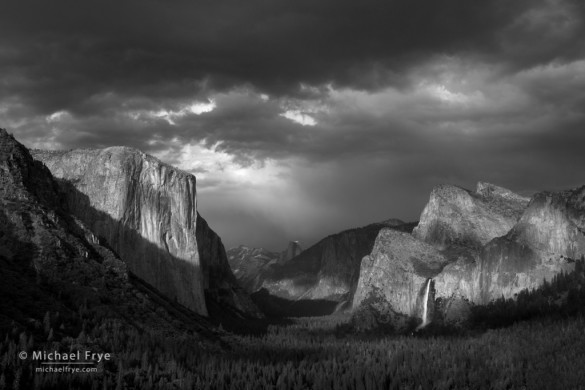
Storm clouds over Yosemite Valley from Tunnel View, Yosemite NP, CA, USA
Within National Parks is room – glorious room – room in which to find ourselves, in which to think and hope, to dream and plan, to rest and resolve.
— Enos A. Mills
Exactly 150 years ago, on June 30th, 1864, President Abraham Lincoln signed the Yosemite Grant, giving Yosemite Valley and the Mariposa Grove to the state of California to be preserved. This is the first instance of park land being set aside specifically for preservation and public use by action of the U.S. federal government, and set a precedent for the 1872 creation of Yellowstone as the first national park. (Yosemite National Park was created in 1890 to protect the lands surrounding Yosemite Valley, and in 1906 the valley and Mariposa Grove were returned to the federal government and incorporated into the national park.)
Photography played a vital role in the creation and passing of the Yosemite Grant legislation. The public thought that the early stories about Yosemite Valley were exaggerated, and drawings and paintings could be manipulated, so people only began to appreciate the magnificence of the valley when they saw proof in the form of photographs by Charles Weed and Carleton Watkins. Watkins’ photographs of Yosemite were displayed in the halls of Congress, and may also have been shown to president Lincoln by Senator John Conness. (You can see an exhibit of Watkins’ photographs at Stanford University in the San Francisco Bay Area through August 17th.)
(more…)
by Michael Frye | Jun 20, 2014 | Advanced Techniques, Composition
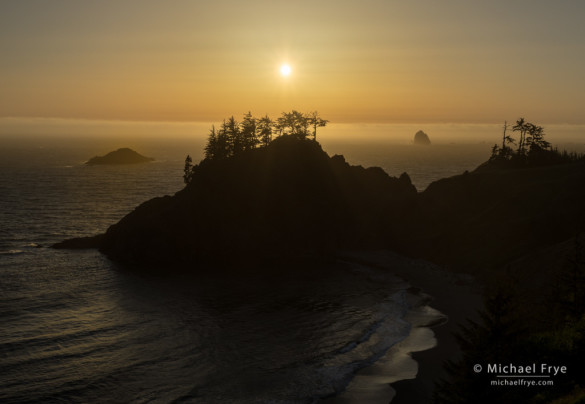
Sun setting over the Pacific Ocean, southern Oregon
After our redwoods workshop, Claudia and I drove north and spent a couple of days along the Oregon coast. I’d never been to this area before, so on our first afternoon we scouted a number of locations north of the town of Brookings. We made several short hikes down steep trails to the coast, with correspondingly steep climbs back out. Though we found some nice spots, none made me jump up and down. Sunset was approaching, and I had to decide where to go. I could see some interesting sea stacks to the north, and decided to drive in that direction.
But we never made it to those sea stacks, because before we could get there we checked one more viewpoint, and immediately realized we didn’t need to go any further. We’d found a scene that practically composed itself, with all the elements nicely balanced and arranged: two stands of silhouetted trees on a ridgeline, with an offshore rock placed perfectly in the gap between the trees, and another rock spaced neatly out to the left. There was even a scalloped line of waves in the foreground to lead the eye toward that gap and the distant rock.
(more…)
by Michael Frye | Jun 18, 2014 | Announcements
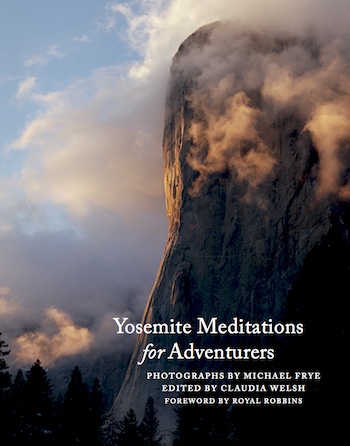 Yosemite has long attracted adventurous people who come to climb, hang glide, ski, or hike through its rugged, wild terrain. Our latest book, Yosemite Meditations for Adventurers, celebrates this spirit of adventure with 45 of my photographs, paired with inspirational quotes about adventure and wild places from people like Galen Rowell, Bill Bryson, Terry Tempest Williams, Yvon Chouinard, Edward Abbey, John Muir, Cheryl Strayed, Lynn Hill, Ron Kauk, and many others, plus a forward by Royal Robbins.
Yosemite has long attracted adventurous people who come to climb, hang glide, ski, or hike through its rugged, wild terrain. Our latest book, Yosemite Meditations for Adventurers, celebrates this spirit of adventure with 45 of my photographs, paired with inspirational quotes about adventure and wild places from people like Galen Rowell, Bill Bryson, Terry Tempest Williams, Yvon Chouinard, Edward Abbey, John Muir, Cheryl Strayed, Lynn Hill, Ron Kauk, and many others, plus a forward by Royal Robbins.
This is the third book in the Yosemite Meditations series, following the original Yosemite Meditations, and Yosemite Meditations for Women. As in the previous editions, my wife Claudia did a great job of editing the book, finding great quotes, and pairing them with the photographs. You’ll find a few sample pages below.
You can hear a bit more about the new book in an interview I did for the Valley Edition show on KVPR, Fresno’s public radio station. The show aired yesterday, but you can listen to it online at their website (my segment starts at minute 28 and lasts about ten minutes).
If you order Yosemite Meditations for Adventurers directly from us through the “Add to Cart” button below, Claudia and I will both sign the book(s). You can also order from the publisher, the non-profit Yosemite Conservancy, or from Amazon.
We hope you like the book, and really appreciate your support! We also want to give our thanks to the Yosemite Conservancy for their continuing commitment to publishing high quality books about the park, and for all the great work they do to help Yosemite.
— Michael Frye
Yosemite Meditations for Adventurers
Hardcover with jacket; approx. 6×5 inches; 96 pages
9.95


(more…)
by Michael Frye | Jun 15, 2014 | Photography Tips
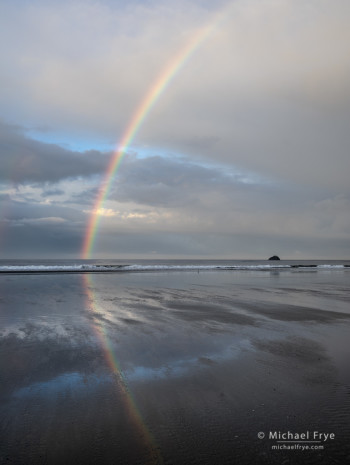
Rainbow, Crescent Beach, Crescent City, CA, USA
It should be obvious that weather and light are important aspects of landscape photography. No matter where you are, it pays to keep an eye on the weather, and to learn local weather patterns.
We arrived in Crescent City about five days before our redwoods workshop was set to begin. Our first night there some showers moved through, and at sunrise it was gray and raining. But online radar and satellite images showed that the showers might end soon, so I prepared to go out. Then through our hotel room window I saw a rainbow! We made a dash for the car, drove out to Crescent Beach, and luckily the rainbow was still there (right).
The weather then settled into a more typical pattern for the season, with frequent coastal fog and low clouds in the mornings, giving way to clear skies in the afternoons. This pattern should be familiar to anyone who has spent time along the California coast in summer.
This fog is the perfect complement to redwood forests. The rhododendrons were also putting on a great display this year, so for the first part of our workshop, and while scouting beforehand, we had beautiful conditions in the redwoods, with fog, rhododendrons, and even sunbeams.
But on the last day of the workshop the wind shifted and pushed the coastal fog offshore. This also happens frequently along the northern California coast, even in summer, as any disturbance in the weather pattern can change the winds and move the fog out to sea. But the offshore wind produced a different kind of fog – valley fog along the Klamath River. I didn’t think we would see valley fog during this visit, because valley fog usually requires damp ground from recent rains, and there hadn’t been much rain in the area. But apparently the river itself provided enough moisture to create fog.
This time the fog flowed along the river toward the sea, and it was local enough, and low enough, for us to get above it near the mouth of the Klamath River. It was a special treat to look out over the fog bank, and then to watch and photograph the sun breaking through the fog and lighting the surf.
(more…)
by Michael Frye | Jun 11, 2014 | Photography Tips
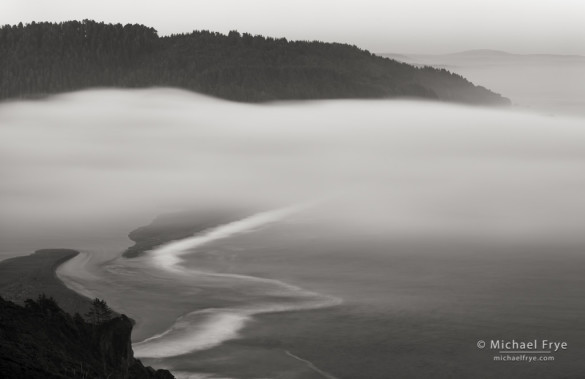
Fog at the mouth of the Klamath River, Redwood NP, CA; 30 seconds
The far northern coast of California has many wonderful, wild coastal areas, providing great opportunities to make moody photographs of ocean scenes. It can be challenging to photograph these scenes, however, because things are constantly changing. In addition to that usual variable – the weather – you have to think about the tides and movement of the waves. Timing can be critical for catching a wave, or pattern of waves, in just the right position, and sometimes you need a lot of patience to wait for the right moment.
Any moving subject – including waves – can lend itself to using slow shutter speeds. With ocean scenes, the blurred motion created by slow shutter speeds can convey a sense of motion more strongly than a frozen image would, or give the water an ethereal quality that adds to the mood of the image. Here’s a small portfolio of my slow-shutter-speed ocean photographs from before, during, and after our workshop, with the shutter speeds included in the captions for each image.
(more…)
by Michael Frye | Jun 8, 2014 | Workshops
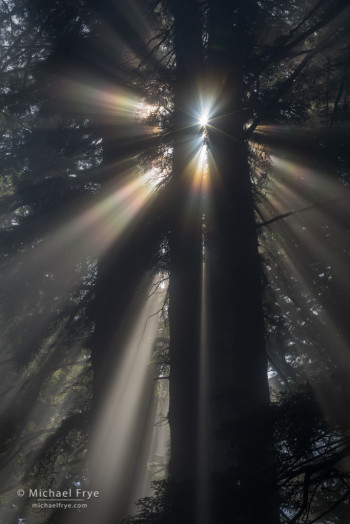
Sunbeams and corona in a redwood forest, northern California, USA
Claudia and I have been up in the redwood country, in far northern California, for the past two weeks. We had such a great time during my Mystic Forest workshop. Like last year, we stayed at the Requa Inn, with its great food, relaxing atmosphere, and beautiful views. We had a wonderful group of people, and I already miss the energy of the group learning and photographing together. And we had great weather, with lots of fog! Here’s one image from our first morning, with the sun breaking through the fog and creating a spectacular triple corona. I’ll post more photographs soon as I get time to process them.
— Michael Frye
Related Posts: In Redwood Country; Back From the Redwoods, and the Lightroom 5 Release
Did you like this article? Click here to subscribe to this blog and get every new post delivered right to your inbox!
Michael Frye is a professional photographer specializing in landscapes and nature. He is the author or principal photographer of The Photographer’s Guide to Yosemite, Yosemite Meditations, Yosemite Meditations for Women, and Digital Landscape Photography: In the Footsteps of Ansel Adams and the Great Masters. He has also written three eBooks: Light & Land: Landscapes in the Digital Darkroom, Exposure for Outdoor Photography, and Landscapes in Lightroom 5: The Essential Step-by-Step Guide. Michael written numerous magazine articles on the art and technique of photography, and his images have been published in over thirty countries around the world. Michael has lived either in or near Yosemite National Park since 1983, currently residing just outside the park in Mariposa, California.
by Michael Frye | May 26, 2014 | Photography Tips
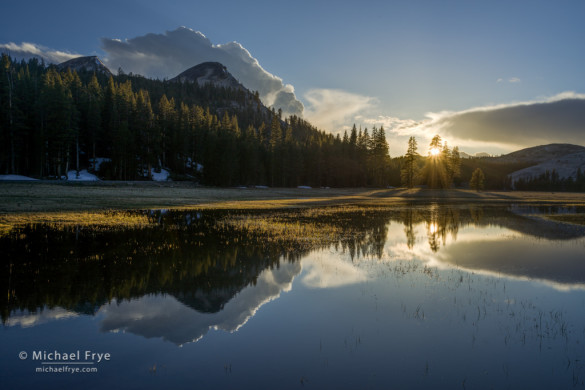
Setting sun, Tuolumne Meadows, 7:39 p.m. Thursday (as the sun sank behind the ridge)
Last week some unseasonal showers reached Yosemite. The showers didn’t bring heavy amounts of precipitation, but enough snow fell at higher elevations to temporarily close Tioga Pass and the Glacier Point Road.
On Thursday the Tioga Road reopened. Since Claudia and I are heading up to the northern coast of California soon for my redwoods workshop, we thought this might be our last chance to go up to the Yosemite high country for awhile, so we decided to drive up to Tuolumne Meadows for the afternoon. There were still some clouds and showers in the area, so the prospect of some interesting weather made the idea even more enticing.
(more…)
by Michael Frye | May 18, 2014 | Photography Tips
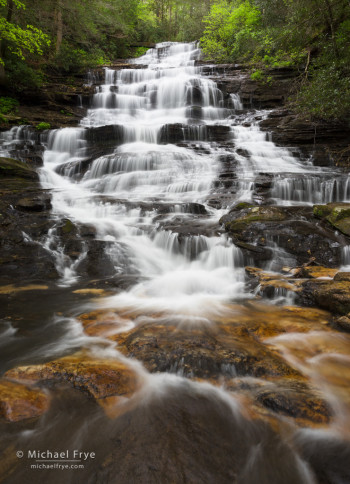
Minnehaha Falls, GA; 1 sec., f/16, ISO 100
Waterfalls are abundant in the southern Appalachians. It seems like you can hardly throw a stick without hitting one.
Of course I’ve spent the last 30 years in Yosemite, which might have the most spectacular collection of waterfalls in the world. But they’re different. Yosemite’s waterfalls are big and dramatic, and often leap hundreds of feet in a single drop. The waterfalls in the southern Appalachians are smaller, more intimate, and more complex, often containing multiple tiers and channels. This complexity can make them both more challenging and more rewarding to photograph – challenging because there’s rarely an immediately-obvious composition, but rewarding because once you start looking you might find a dozen or more good compositions in a single cascade.
During our last trip, one of the first places we visited was Minnehaha Falls in northern Georgia. Since this fall is on the cover of two different waterfall guidebooks it seemed worth checking out. And we weren’t disappointed. Minnehaha is graceful enough to lend itself to overall views, and intricate enough to offer many smaller-scale compositions. The day was overcast, which is often ideal for these kind of waterfalls. I spent an hour and a half there working just one side of the cascade before we had to move on.
(more…)



















